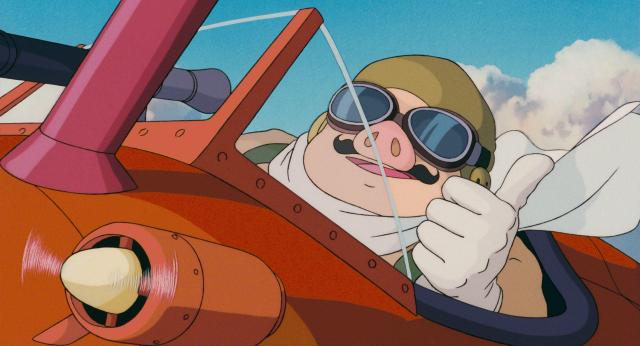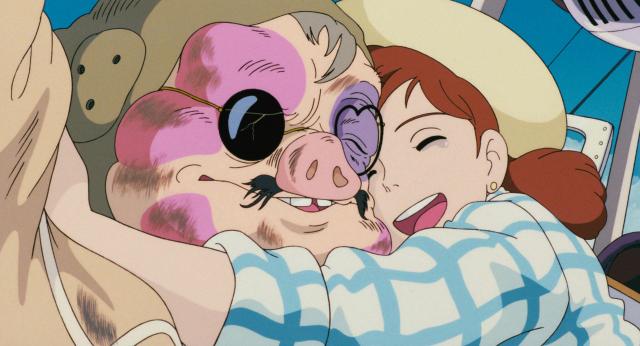
Insider revelations shed new light on the beloved anime film.
TV viewers in Japan have had a great start to the year, with broadcaster Nippon TV airing two Studio Ghibli films in its “Friday Roadshow” weekly movie slots for the first two weeks of 2022.
On 7 January, Ghibli’s 2001 film Spirited Away was broadcast, with the studio answering fan questions about the movie while it aired as part of a special Q&A session on Twitter. Then, on 14 January, Ghibli’s 1992 film Porco Rosso was broadcast, and this time Nippon TV’s official Friday Roadshow Twitter account was on hand to provide interesting snippets of background information and behind-the-scenes secrets for viewers.
Friday Roadshow shared a barrage of constant updates throughout the evening, so let’s take a look at some of the highlights below.
Porco Rosso wasn’t intended to be a feature-length film
“Initially, this work, which started out as a 30-minute-long video project, was made to be screened inside planes in order to garner a big budget. After that, the content became more in-depth and it looked like it was going to exceed 60 minutes, so it was made into a feature-length film.”
当初、30分ほどのビデオ作品企画として始まった本作は、予算を多く取るために飛行機内🛫での上映用作品として制作されることになりました。その後、内容が深みを増し、60分を超えそうになってきたため、劇場用作品📽として作ることになりました🤗#金曜ロードショー#紅の豚#宮崎駿#スタジオジブリ pic.twitter.com/30gzI9h4hK
— アンク@金曜ロードショー公式 (@kinro_ntv) January 14, 2022
The feature-length Porco Rosso was produced by Studio Ghibli in collaboration with a number of companies, including Nippon TV and Japan Airlines. This fact prompted one fan to shared a photo of a 1992 JAL inflight magazine promoting the film.
元々日航用でしたからねぇ☺️ pic.twitter.com/u3ioN6mTXb
— 下町のRYO (@Ryo_s030214) January 14, 2022
The Translation for the Opening Scene
“The opening subtitles in 10 languages was an idea written into the storyline from the beginning. Translators were asked to translate the text, but they had a hard time confirming [its accuracy]. Using various connections, ‘language masters’ for each language, such as university lecturers, embassy staff, and overseas TV station employees, checked the translations in time for the release.”
オープニングの10か国語字幕は、初期のストーリー案にも書かれていたアイデアです。翻訳業者に頼んで訳文が一応出来たものの、その確認が一苦労。様々なツテをたどって、大学の先生や大使館の職員、海外テレビ局の社員といった各国語それぞれの“語学の達人”にチェックして貰い公開に間に合わせました。 pic.twitter.com/hKezISAYng
— アンク@金曜ロードショー公式 (@kinro_ntv) January 14, 2022
Because the ten-language translation was part of the story from the very beginning, a number of fans believe this was part of the initial agreement to show the film on JAL’s international flights.
Porco Rosso is based on a Miyazaki Manga
“Porco Rosso is based on ‘The Age of the Flying Boat’ episode from Hayao Miyazaki’s Zassou Note, which was serialised in Monthly Model Graphix. The dynamic scene of Mamma Aiuto’s ‘bounty hunter’ is drawn in Part 1.”
「#紅の豚」は『月刊モデルグラフィックス』で #宮崎駿🎬監督が連載していた『#宮崎駿の雑想ノート』の中の「#飛行艇時代」のエピソードが原作です。#マンマユート団 相手の“賞金稼ぎ”のダイナミックなシーンは、第1回に描かれています🤗#金曜ロードショー#スタジオジブリ pic.twitter.com/LTt2xVs7sq
— アンク@金曜ロードショー公式 (@kinro_ntv) January 14, 2022
Why Porco Rosso Remains a Pig Throughout the Film
“Director Miyazaki said, ‘I think it’s more true-to-character for Porco to live as a pig right to the end’. When Porco appeared in the sunlight, as a pig, that’s who Gina fell in love with.”
#宮崎駿🎬監督は「ポルコは豚のまま最後まで生きていくほうが本当にこの男らしいと思う」と語っています。#ジーナ は、#ポルコ が豚のまま日差しの中に現れたらそれを愛そうと決めているのだと。#金曜ロードショー#紅の豚 pic.twitter.com/YLftDzxdqw
— アンク@金曜ロードショー公式 (@kinro_ntv) January 14, 2022
Gina is Argentinian
“Pay attention to the flag on the boat owned by Gina. Even though it’s set in the Adriatic Sea, the flag of Argentina is raised. It seems that this is because Gina’s backstory includes the fact that she’s Argentinian.”
#ジーナ が所有している船🚤に掲げられている旗🏳️に注目。アドリア海が舞台なのに、アルゼンチンの国旗風の旗が掲げられているのです。これはジーナがアルゼンチン🇦🇷国籍だという裏設定があるからなんだそうです🤗#金曜ロードショー#紅の豚#宮崎駿#スタジオジブリ pic.twitter.com/lnAyuGJjLI
— アンク@金曜ロードショー公式 (@kinro_ntv) January 14, 2022
A Forever Farewell?
“Tokiko Kato, who played Gina, felt that the scene in which Gina and Porco stared at each other was a “forever farewell”. However, Miyazaki said it wouldn’t matter if Porco were to appear at Gina’s bar afterwards as if nothing had happened.”
#ジーナ を演じた #加藤登紀子🎤さんは、2人が見つめ合うシーンが2人の“永遠の別れ”だと感じたのだそうです。一方、#宮崎駿🎬監督は、この後 #ポルコ が何もなかったようにジーナの店に現れてもちっともかまわないと言っています。#金曜ロードショー#紅の豚 pic.twitter.com/fvY5D6QjRs
— アンク@金曜ロードショー公式 (@kinro_ntv) January 14, 2022
The film’s open ending leaves many viewers reading into that final look shared between the two characters to see if it revealed anything about their possible future together. However, Miyazaki’s statement can lay rest to any fears about this being a “forever farewell”.
Two Producers had Cameos in the Film
“At the time of recording Kato’s song, Ghibli producer Toshio Suzuki and former Nippon TV producer Seiji Okuda decided to play customers at Gina’s bar. In the scene they were in, the man who takes Gina’s hand with a nervous look was based on Okuda’s performance, and the man with glasses behind him was based on Suzuki’s performance.”
#加藤登紀子🎤さんの歌の収録時、プロデューサーの #鈴木敏夫 さんと元NTV #奥田誠治 さんはジーナの店を訪れるお客さんを演じることに🤗出来上がったシーンでは、ジーナに手を取られて緊張気味の男性は奥田さんが、その後ろのメガネの男性は鈴木さんの演技が元になっています😆#金曜ロードショー pic.twitter.com/82ls4buUEc
— アンク@金曜ロードショー公式 (@kinro_ntv) January 14, 2022
Animating the French Singing Scene
“The audio for ‘Le Temps Des Cerises’, sung by Gina at the hotel bar, was recorded at a Russian restaurant in Aoyama [in Tokyo]. This scene was shot in advance with a video camera, and Miyazaki used it for reference when drawing the scene. Take note of Gina “reenacting” Kato’s mouth movements as she sings in French.”
#ジーナ がホテルのバーで歌う「#さくらんぼの実る頃」の音源は、青山のロシア料理屋さんで収録。このシーンを前もってビデオ📹で撮っておき、それを参考に #宮崎駿🎬監督は絵を描こうとしたそうです。フランス語🇫🇷で歌う加藤さんの口の動きをそのまま“再現”されているジーナに注目です🤗#紅の豚 pic.twitter.com/B7Y3DH6Lqr
— アンク@金曜ロードショー公式 (@kinro_ntv) January 14, 2022
Kato, an acclaimed singer and actress, shared a video message with fans before the broadcast, asking them to watch the show. She also joked that today was Valentine’s Day, before correcting herself to say it was actually a month before Valentine’s Day.
これから金曜ロードショーで「紅の豚」放送です!
— 加藤登紀子 (@TokikoKato) January 14, 2022
一緒に観ましょう!#紅の豚 #ジーナ #加藤登紀子 #金曜ロードショー pic.twitter.com/63mJflT7PH
Porco Smokes the Same Brand of Cigarettes as Another Anime Character
“The cigarette that’s constantly in Porco’s mouth is Gitanes, a representative brand of cigarettes from France. Porco seems to like the ones with both ends cut off. It’s the brand that Lupine III [from The Castle of Cagliostro] also smokes.”
#ポルコ が常に口にくわえているのは、フランス🇫🇷を代表するタバコ“#ジタン”。両端が切り落とされているものがポルコのお気に入りらしいです。ルパン三世も吸っている銘柄なんですよ😆‼️#金曜ロードショー#紅の豚#宮崎駿#スタジオジブリ pic.twitter.com/WuSUlfaEcO
— アンク@金曜ロードショー公式 (@kinro_ntv) January 14, 2022
The Castle of Cagliostro, known in Japan as Lupin III: Cagliostro no Shiro, is a 1979 Japanese anime film that was co-written and directed by Miyazaki, although it pre-dates the 1985 founding of Studio Ghibli.
The Motives Behind the Characters
“In his proposal for Porco Rosso, Miyazaki clearly wrote, ‘The main characters all adhere to a reality carved out by their lives. They fool around because they’ve experienced tough times. They’ve acquired simplicity through maturity. We have to cherish every character. That stupidity should be loved, and cutting corners with the portrayal of other characters in the crowd is to be avoided. The common mistake — the misconception that drawing someone dumber than you is manga — must not be made.”
続き👉そのバカさを愛すべし、その他大勢の描写に手ぬきは禁物。よくある誤り―自分よりバカなものを描くのがマンガという誤解—を犯してはならない。」と明確にしていたそうです🤗#金曜ロードショー#紅の豚#スタジオジブリ
— アンク@金曜ロードショー公式 (@kinro_ntv) January 14, 2022
Professional actors often say that characters are multifaceted and therefore should never be viewed as either good or bad. Miyazaki’s statements prove he too has a deep level of understanding and affection for characters and their background stories, which is why they connect so well with audiences.
Using Colour to Express a Change in Porco’s Mental State
“In the scene where Porco tells Fio a story, there was a direction to change Porco’s psychological state with “colour”!! Before he tells the story, the shadow hues are blue. After the story is over, they change to brown.”
#ポルコ が #フィオ に昔の話をするシーンでは、ポルコの心理状態の変化を“色”で語る演出が😳‼️昔の話をする前は影の色はブルー系なのですが、話が終わった後は茶系に変化するようになっています🤗#金曜ロードショー#紅の豚#宮崎駿#スタジオジブリ pic.twitter.com/2sxMsJOcT7
— アンク@金曜ロードショー公式 (@kinro_ntv) January 14, 2022
A New Heart on Curtis’ Plane
“Pay attention to the white section on the rear body of Curtis’ beloved plane, his R3C-O. At the beginning of the story, there’s no pattern in this section, but during the final battle with Porco, an illustration of a heart pierced with an arrow has been added.”
#カーチス の愛機“#カーチスR3C-O”のボディの後ろ側の白いラインの部分に注目‼️物語の最初ではラインの部分に模様は描かれていないのですが、#ポルコ🐽との最終決戦ではハートに矢が刺さったイラストが加えられています😳#金曜ロードショー#紅の豚#宮崎駿#スタジオジブリ pic.twitter.com/EuIPCtb6j9
— アンク@金曜ロードショー公式 (@kinro_ntv) January 14, 2022
▼ Another heart appears in the frame of Porco’s glasses after their punch-up, proving that love is truly at the centre of this tale.
The Inspiration for Porco’s Plane
“‘Savoia’ is a manufacturer that actually existed in Italy, but Porco’s beloved plane, the “Savoia S.21 prototype combat flying boat” is a fictitious aerial flying boat created by Miyazaki. It’s said to be modelled on the ‘Macchi M.33’ flying boat that was in the Schneider Trophy race.”
“#サボイア”というのはイタリア🇮🇹に実在したメーカーですが、#ポルコ の愛機“サボイアS-21試作戦闘飛行艇”は、#宮崎駿🎬監督が生み出した架空の飛行艇。シュナイダー・トロフィー・レースで活躍した飛行艇“マッキM.33”がモデルと言われています🤗#金曜ロードショー#紅の豚#スタジオジブリ pic.twitter.com/JGOygX64B4
— アンク@金曜ロードショー公式 (@kinro_ntv) January 14, 2022
The Meaning of the Letter “R”
“The symbol on the tail of Porco’s aircraft is modelled on the city emblem of Porco’s hometown of Genova. The letter “R” above it is said to be taken from the first letter of ROSSO and Republican (Repubbicano).”
#ポルコ の愛機の尾翼に書いてあるマークは、ポルコの故郷であるジェノバ市の市章をモデルにしています。その上の「R」の文字はROSSOと共和主義者(Repubbicano)の頭文字から取られているそうです🤔#金曜ロードショー#紅の豚#宮崎駿#スタジオジブリ pic.twitter.com/sf7A4CPC0l
— アンク@金曜ロードショー公式 (@kinro_ntv) January 14, 2022
We knew Porco was a Republican when he said he’d rather be a pig than a fascist in the film.
Porco Rosso Turned Himself Into a Pig?
“Porco’s real name is Marco Pagot. Born in 1893. The name is taken from the Italian producer of Sherlock Hound, which Miyazaki directed. “Porco Rosso” is a nickname given to the character by the sky pirates. After World War I, he retired from the Italian army and performed a spell on himself to turn himself into a pig.”
ポルコの本名はマルコ・パゴットです。1893年生まれ。名前は宮崎駿監督が参加した「#名探偵ホームズ」のイタリア側プロデューサーから引用。『ポルコ・ロッソ』は空賊達が付けたニックネームです。第1次世界大戦後にイタリア軍を退役し、自分で自分に魔法をかけて豚になりました。#紅の豚 pic.twitter.com/BunTcw6HIx
— キャッスル@ジブリフリーク (@castle_gtm) January 14, 2022
The above tweet comes from a diehard Ghibli fan, who included photos of the above-mentioned statements, which appeared in the movie booklet that was published when the movie was first released. Sherlock Hound is an Italian-Japanese anime TV series that debuted in 1984, eight years before Porco Rosso debuted in Japanese cinemas.
Porco’s Face Returns to its Human Form…But Only Sometimes
“Curtis is surprised when he sees Porco’s face, but Miyazaki says that doesn’t mean Porco has returned to his human form. Although his face sometimes returns to its human form, it seems that it goes back to looking like a pig straight away.”
ポルコの顔を見てカーチスは驚きますが、宮崎駿監督いわくポルコは人間に戻ったわけではないようです。時々人間の顔に戻ることはあっても、すぐに豚に戻ってしまうそうです。#紅の豚 pic.twitter.com/ESWSMsQtwT
— キャッスル@ジブリフリーク (@castle_gtm) January 14, 2022
That same Ghibli fan posted the above tweet with photos from the same booklet to back up the statements. It certainly does align with Miyazaki’s previous assertion that Porco should remain as a pig throughout the film.
The Federation of Air Pirates is a Multinational Organisation
“The bosses in the Federation of Air Pirates, an organisation formed by seven groups of air pirates based in the Adriatic Sea, have different birthplaces. The boss wearing an eyepatch is from France, while others are from Switzerland, Sicily, Provence, Croatia. There also appears to be Norman descendants and aristocratic descendants from the Austro-Hungarian Empire.”
アドリア海🌊を拠点に活動する空賊の7グループが作っている組織、空賊連合のボス達はそれぞれ出身地が違います。眼帯をしているボスはフランス🇫🇷出身で、他にもスイス🇨🇭、シチリア、プロヴァンス、🇭🇷出身。ノルマン人やオーストリア=ハンガリー帝国の貴族の末裔もいるそうです😳#金曜ロードショー pic.twitter.com/SXG5Tp1I3N
— アンク@金曜ロードショー公式 (@kinro_ntv) January 14, 2022
The Real-Life Major Ferrarin
https://twitter.com/Italia_Luciano/status/1481971643073597440“Porco’s comrade, Ferrarin, was modelled on Arturo Ferrarin, the pilot who made the world’s first European-Far East flight between Rome and Tokyo!”
A Tribute to Porco’s Voice Actor
“Shuichiro Moriyama, who played Porco. He dubbed roles like Telly Savalas’ in the drama Kojak. Unfortunately, he passed away last year.”
#ポルコ を演じた #森山周一郎🗣さん。ドラマ「#刑事コジャック」のテリー・サバラスの吹き替え🎙などで活躍されました。残念ながら、昨年お亡くなりになりました。#金曜ロードショー#紅の豚#宮崎駿#スタジオジブリ pic.twitter.com/QImO76R9Js
— アンク@金曜ロードショー公式 (@kinro_ntv) January 14, 2022
Japanese voice actor Moriyama was the official Japanese dub artist for actors like Spencer Tracy, Telly Savalas, Jean Gabin and Lino Ventura. Moriyama passed away in February last year, at the age of 86.
Debut Role for a Famous One Piece Voice Actress
“Fio was played by Akemi Okamura, who’s known for playing the role of Nami in One Piece. She made her voice acting debut in Porco Rosso.”
#フィオ を演じたのは、『ONE PIECE』のナミ役でおなじみの #岡村明美🗣さん。本作がデビュー作でした🎉#金曜ロードショー#紅の豚#宮崎駿#スタジオジブリ pic.twitter.com/7u1wubW5kr
— アンク@金曜ロードショー公式 (@kinro_ntv) January 14, 2022
Fio’s Older Sister
“Among the female relatives working at the Piccolo factory, the woman wearing a cream-coloured dress is Fio’s older sister, Giliora. On the storyboard for this scene, “Fio, Five years later” is written.”
#ピッコロおやじ🛠の工場で働く親族の女性たちの中で、クリーム色のワンピース👗を着ている女性が、#フィオ のお姉さんの #ジリオラ。このシーンの絵コンテには“フィオの5年後”と書かれているそうです😆#金曜ロードショー#紅の豚#宮崎駿#スタジオジブリ pic.twitter.com/rlzbZ9NXiK
— アンク@金曜ロードショー公式 (@kinro_ntv) January 14, 2022
So that’s what Fio would look like in five years’ time!
Women Played Main Roles in the Film, and also at Studio Ghibli
“At Mr Piccolo’s factory, the men are all working away from home, so women gather together to work. Actually, at Studio Ghibli as well, women like animation director Megumi Kagawa and art director Kazu Hisamura occupied main roles, which was an unprecedented arrangement in the animation industry at that time.”
#ピッコロおやじ🛠の工場では、男たちが出稼ぎに行っているので、女性ばかりが集まって作業をしています😳
— アンク@金曜ロードショー公式 (@kinro_ntv) January 14, 2022
実は本作🎞の制作現場も、作画監督🖌の #賀川愛 さん、美術監督🎨の #久村佳津 さんをはじめ、メインスタッフを女性が占めていて、当時のアニメーション業界では異例の体制でした🤗#金曜ロード pic.twitter.com/300Utmpz6e
A Hat From Another Ghibli Film
“On the image board for Mr Piccolo, drawn by Miyazaki, he added the note ‘Pazu Hat’!! The design of the blue hat worn by Mr Piccolo is based on the blue hat worn by Pazu in Laputa: Castle in the Sky.”
#宮崎駿🎬監督が描いた #ピッコロおやじ のイメージボードには「#パズー帽」と説明が…‼️ピッコロおやじがかぶっている青い帽子のデザインの元になっているのは、「#天空の城ラピュタ」の #パズー がかぶっている帽子だったんですね😆#金曜ロードショー#紅の豚#スタジオジブリ pic.twitter.com/0ieuzkysnH
— アンク@金曜ロードショー公式 (@kinro_ntv) January 14, 2022
Ghibli Leaves its Mark on an Engine
“The engine in the Piccolo warehouse. If you look closely at the engraved sign…!?”
ピッコロ社の倉庫にあったエンジン。刻印をよく見ると…⁉️#金曜ロードショー#紅の豚#宮崎駿#スタジオジブリ pic.twitter.com/JhXiMKWqJa
— アンク@金曜ロードショー公式 (@kinro_ntv) January 14, 2022
Yes, that sign reads “Ghibli” in all caps, even though the engine is meant to be a Fiat A.S.2 “Folgore” V-12. It’s not just the studio that’s referenced with the appearance of the word “Ghibli”, though — the Caproni Ca.309 Ghibli was an Italian aircraft used in World War II, and its nickname, “Ghibli”, means “desert wind”, which is where the studio gets its name from.
The Pigs in Planes at the End of the Film
“The 22 illustrations seen during the ending were all created by Hayao Miyazaki. The pigs he drew are said to reflect the notion that airplanes were beginning to be used as a means for various interests in the world, and men who had to fly in the sky on a “mission” would be unable to escape from a certain type of shamefulness.”
エンディングで流れる22枚のイラストはすべて宮崎駿監督が手掛けたものです。描かれている豚には、地上の色々な利害関係の道具として飛行機が利用されはじめ、「任務」として空を飛ばなければいけなくなった男たちがある種の苦々しさなどから免れることはできないという思いが反映されているそうです。 pic.twitter.com/FLRfX8BtoS
— アンク@金曜ロードショー公式 (@kinro_ntv) January 14, 2022
The messaging is certainly deep in Porco Rosso, a film coloured by the backdrop of war and conflict and set during a period of rapid change. However, Miyazaki perfectly navigates us through the film with equal amounts of hope and humour, leading many fans to rate it as one of their favourite Ghibli films.
With the film based on an original Miyazaki manga, the studio itself named after one of Miyazaki’s favourite planes that made it into the story, and Mamma Aiuto, the name of the Sky Pirates, serving as the name for the Ghibli Museum gift shop, it’s clear to say that this underrated work is one of Miyazaki’s favourite films too.
Source: Twitter/@kinro_ntv via Hachima Kikou
Top image: Studio Ghibli
Insert image: Studio Ghibli
● Want to hear about SoraNews24’s latest articles as soon as they’re published? Follow us on Facebook and Twitter!


 Now’s your chance to ask Studio Ghibli ANYTHING you want about Princess Mononoke
Now’s your chance to ask Studio Ghibli ANYTHING you want about Princess Mononoke Who is No Face? Hayao Miyazaki finally gives us the answer
Who is No Face? Hayao Miyazaki finally gives us the answer New Studio Ghibli sunglasses will make anime fans look like fat pigs
New Studio Ghibli sunglasses will make anime fans look like fat pigs Porco Rosso punching puppets bring anime rivalry to life in beautiful way
Porco Rosso punching puppets bring anime rivalry to life in beautiful way Gorgeous handmade, made-in-Japan Ghibli leather wallets return to Donguri Kyowakoku【Photos】
Gorgeous handmade, made-in-Japan Ghibli leather wallets return to Donguri Kyowakoku【Photos】 How to order snacks on a Shinkansen bullet train in Japan
How to order snacks on a Shinkansen bullet train in Japan Japan’s new difficult-to-drink-from beer glass protects your liver, but it’s a brutal experience
Japan’s new difficult-to-drink-from beer glass protects your liver, but it’s a brutal experience Burger King Japan suddenly adds Dr. Pepper and Dr. Pepper floats to its menu nationwide
Burger King Japan suddenly adds Dr. Pepper and Dr. Pepper floats to its menu nationwide Demon Slayer: Kimetsu no Yaiba gets new roller coaster attractions and food at Universal Studios Japan
Demon Slayer: Kimetsu no Yaiba gets new roller coaster attractions and food at Universal Studios Japan Hello, cosmetics! Clinique teams up with Hello Kitty this summer for first-time collaboration
Hello, cosmetics! Clinique teams up with Hello Kitty this summer for first-time collaboration Kyoto Tower mascot termination reveals dark side behind cute Japanese characters
Kyoto Tower mascot termination reveals dark side behind cute Japanese characters Nintendo history you can feel – Super NES, N64, and GameCube controllers become capsule toys
Nintendo history you can feel – Super NES, N64, and GameCube controllers become capsule toys This Nara workshop has been making deer crackers for more than 100 years and offers tours【Photos】
This Nara workshop has been making deer crackers for more than 100 years and offers tours【Photos】 High-fashion Totoro cuddle purse is like an elegant stroll in the forest【Photos】
High-fashion Totoro cuddle purse is like an elegant stroll in the forest【Photos】 Legendary Melon Bread by Tokyo Banana returns after 20-year absence【Taste Test】
Legendary Melon Bread by Tokyo Banana returns after 20-year absence【Taste Test】 “The most Delicious Cup Noodle in history” – Japan’s French Cup Noodle wins our heart【Taste test】
“The most Delicious Cup Noodle in history” – Japan’s French Cup Noodle wins our heart【Taste test】 Starbucks releases a cute Frappuccino and Unicorn Cake…but not in Japan
Starbucks releases a cute Frappuccino and Unicorn Cake…but not in Japan McDonald’s Japan’s Soft Twist Tower: A phantom ice cream only sold at select branches
McDonald’s Japan’s Soft Twist Tower: A phantom ice cream only sold at select branches Yabai Ramen: What makes this Japanese ramen so dangerous?
Yabai Ramen: What makes this Japanese ramen so dangerous? Finally! Nintendo Japan expands Switch 8-bit controller sales to everybody, Online member or not
Finally! Nintendo Japan expands Switch 8-bit controller sales to everybody, Online member or not Japanese government wants to build luxury resorts in all national parks for foreign tourists
Japanese government wants to build luxury resorts in all national parks for foreign tourists To combat declining birth rate, Japan to begin offering “Breeding Visas” to foreigners
To combat declining birth rate, Japan to begin offering “Breeding Visas” to foreigners 10 things you should buy at 7-Eleven in Japan
10 things you should buy at 7-Eleven in Japan Studio Ghibli releases anime heroine cosplay dresses that are super comfy to wear
Studio Ghibli releases anime heroine cosplay dresses that are super comfy to wear Woman charged for driving suitcase without a license in Osaka
Woman charged for driving suitcase without a license in Osaka Studio Ghibli unveils My Neighbour Totoro miniature house model
Studio Ghibli unveils My Neighbour Totoro miniature house model Kyoto experiencing problems with foreign tourists not paying for bus fares, but not on purpose
Kyoto experiencing problems with foreign tourists not paying for bus fares, but not on purpose Fighting mild hunger with a Japanese soda that turns into jelly in the stomach【Taste test】
Fighting mild hunger with a Japanese soda that turns into jelly in the stomach【Taste test】 Studio Ghibli’s Howl’s Moving Castle tapestry unveiled in Japan for first time
Studio Ghibli’s Howl’s Moving Castle tapestry unveiled in Japan for first time McDonald’s new Happy Meals offer up cute and practical Sanrio lifestyle goods
McDonald’s new Happy Meals offer up cute and practical Sanrio lifestyle goods Sales of Japan’s most convenient train ticket/shopping payment cards suspended indefinitely
Sales of Japan’s most convenient train ticket/shopping payment cards suspended indefinitely Sold-out Studio Ghibli desktop humidifiers are back so Totoro can help you through the dry season
Sold-out Studio Ghibli desktop humidifiers are back so Totoro can help you through the dry season Japanese government to make first change to romanization spelling rules since the 1950s
Japanese government to make first change to romanization spelling rules since the 1950s Foreigner’s request for help in Tokyo makes us sad for the state of society
Foreigner’s request for help in Tokyo makes us sad for the state of society Ghibli founders Toshio Suzuki and Hayao Miyazaki contribute to Japanese whisky Totoro label design
Ghibli founders Toshio Suzuki and Hayao Miyazaki contribute to Japanese whisky Totoro label design Doraemon found buried at sea as scene from 1993 anime becomes real life【Photos】
Doraemon found buried at sea as scene from 1993 anime becomes real life【Photos】 Tokyo’s most famous Starbucks is closed
Tokyo’s most famous Starbucks is closed Princesses, fruits, and blacksmiths: Study reveals the 30 most unusual family names in Japan
Princesses, fruits, and blacksmiths: Study reveals the 30 most unusual family names in Japan Studio Ghibli releases 250 more free-to-download/use images from five films, and Totoro is here!
Studio Ghibli releases 250 more free-to-download/use images from five films, and Totoro is here! Anime fans pick which Ghibli heroine they’d like to have as a girlfriend
Anime fans pick which Ghibli heroine they’d like to have as a girlfriend Studio Ghibli releases beautiful color vinyl record anime soundtrack series, available now【Pics】
Studio Ghibli releases beautiful color vinyl record anime soundtrack series, available now【Pics】 Ghibli Window Wall Art series turns any wall into a portal to an anime wonderland【Photos】
Ghibli Window Wall Art series turns any wall into a portal to an anime wonderland【Photos】 British newspaper ranks the best Studio Ghibli films and reader passions flare
British newspaper ranks the best Studio Ghibli films and reader passions flare Ghibli Park: Opening date, first photos, and a new promo video produced by Studio Ghibli!
Ghibli Park: Opening date, first photos, and a new promo video produced by Studio Ghibli! 10 best Studio Ghibli anime, as picked by Japanese fans– Different ages have different answers
10 best Studio Ghibli anime, as picked by Japanese fans– Different ages have different answers Artist carves cute Studio Ghibli characters into Oreo cookie filling 【Video】
Artist carves cute Studio Ghibli characters into Oreo cookie filling 【Video】 Trailer for Totoro character designer’s new movie is a sampler of Ghibli’s best themes 【Video】
Trailer for Totoro character designer’s new movie is a sampler of Ghibli’s best themes 【Video】 Which Studio Ghibli heroine is the most beloved of all time? Vote for your favorite here!
Which Studio Ghibli heroine is the most beloved of all time? Vote for your favorite here! Studio Ghibli announces release date for Hayao Miyazaki’s new anime movie, releases key art
Studio Ghibli announces release date for Hayao Miyazaki’s new anime movie, releases key art Hayao Miyazaki Working on Proposed New Anime Feature Film
Hayao Miyazaki Working on Proposed New Anime Feature Film Whimsical Ghibli Studio-style animation appears in bread commercials【Videos】
Whimsical Ghibli Studio-style animation appears in bread commercials【Videos】 Hayao Miyazaki is getting worried about how his new anime is being marketed, Ghibli producer says
Hayao Miyazaki is getting worried about how his new anime is being marketed, Ghibli producer says Italian jazz pianist unleashes inner Ghibli fanboy, releases anime theme song album
Italian jazz pianist unleashes inner Ghibli fanboy, releases anime theme song album Miyazaki Blu-ray collection to be released with special bonus content but won’t come cheap!
Miyazaki Blu-ray collection to be released with special bonus content but won’t come cheap!
Leave a Reply